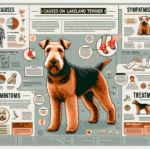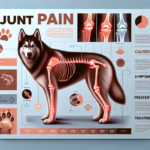Lakeland Terrier Joint Pain: Causes, Symptoms, Prevention, and Treatment

Introduction
The Lakeland Terrier is a small, sturdy breed known for its spirited personality and distinctive appearance. Originating from the Lake District in England, this breed was initially developed for hunting foxes and other small game. With a wiry coat, expressive eyes, and a confident demeanor, the Lakeland Terrier is both a capable working dog and a charming companion. Despite their robust nature, Lakeland Terriers, like many breeds, are susceptible to certain health issues, including joint pain.
Joint health is a critical aspect of overall well-being for any dog, but it holds particular importance for breeds like the Lakeland Terrier. Given their active lifestyle and genetic predispositions, maintaining healthy joints is essential to ensure they lead a comfortable and active life. This article delves into the causes, symptoms, prevention, and treatment of joint pain in Lakeland Terriers, providing a comprehensive guide for owners to keep their pets healthy and happy.
Breed-Specific Joint Pain Risks
Genetic Predisposition
Like many purebred dogs, Lakeland Terriers have a genetic predisposition to certain joint-related issues. Conditions such as hip dysplasia, elbow dysplasia, and arthritis are not uncommon in this breed. Hip dysplasia, in particular, is a hereditary condition where the hip joint does not fit into the hip socket properly, leading to pain and mobility issues. Similarly, elbow dysplasia involves abnormal development of the elbow joint, causing discomfort and lameness.
Age-Related Risks
As Lakeland Terriers age, the risk of developing joint pain increases. While they are generally a healthy breed, the wear and tear on their joints over the years can lead to conditions like osteoarthritis. Owners should be vigilant as their dogs approach middle age, typically around 6-8 years, and monitor for any signs of joint discomfort.
Activity Level and Joint Stress
Lakeland Terriers are known for their high energy levels and love for physical activity. Whether they are participating in agility courses, hunting, or simply playing fetch, their active lifestyle can put significant stress on their joints. While exercise is crucial for their overall health, excessive or high-impact activities can exacerbate joint issues, making it essential to strike a balance.
Common Symptoms of Joint Pain in Lakeland Terriers
General Symptoms
- Limping: One of the most noticeable signs of joint pain is limping or favoring one leg over another.
- Stiffness: Dogs may show stiffness, especially after resting or sleeping, which can indicate joint discomfort.
- Reluctance to Move: A dog that is hesitant to jump, climb stairs, or engage in physical activities may be experiencing joint pain.
- Swelling: Visible swelling around the joints can be a sign of inflammation and pain.
- Behavioral Changes: Increased irritability or changes in behavior can also be indicative of pain.
Breed-Specific Symptoms
In Lakeland Terriers, joint pain may manifest in specific ways due to their unique build and activity patterns. Owners might notice a decrease in their dog’s enthusiasm for activities they once enjoyed, such as digging or chasing. Additionally, the breed’s natural resilience might mask early signs of discomfort, making it crucial for owners to be observant and proactive.
When to Consult a Vet
If any of the above symptoms are observed, it is essential to consult a veterinarian promptly. Early diagnosis and intervention can significantly improve the quality of life for a dog suffering from joint pain. Regular veterinary check-ups are also recommended to monitor joint health and catch any issues early.
Preventive Measures for Joint Health
Exercise Recommendations
Regular, moderate exercise is key to maintaining joint health in Lakeland Terriers. Activities such as walking, swimming, and controlled play can help keep their joints flexible and muscles strong without causing excessive stress. Avoid high-impact activities like jumping from heights or running on hard surfaces, which can exacerbate joint issues.
Dietary Suggestions
A balanced diet rich in essential nutrients is crucial for joint health. Foods containing glucosamine and chondroitin can support joint function and repair. Omega-3 fatty acids, found in fish oil, have anti-inflammatory properties that can help reduce joint pain. Consult with a veterinarian to determine the best diet and supplements for your Lakeland Terrier.
Weight Management
Maintaining a healthy weight is vital to reduce stress on the joints. Overweight dogs are at a higher risk of developing joint problems due to the additional load on their joints. Regular exercise and a balanced diet can help keep your Lakeland Terrier at an optimal weight. Monitoring their weight and adjusting their diet as needed is essential for long-term joint health.
Early Screening and Monitoring
Early screening for joint issues can help catch problems before they become severe. Regular veterinary check-ups should include joint assessments, especially as the dog ages. Genetic testing can also identify predispositions to certain joint conditions, allowing for proactive management.
Treatment Options for Joint Pain
Non-Surgical Treatments
For mild to moderate joint pain, non-surgical treatments can be highly effective. These may include:
- Medications: Anti-inflammatory drugs and pain relievers can help manage symptoms and improve quality of life.
- Physical Therapy: Exercises and therapies designed to strengthen muscles and improve joint flexibility can be beneficial.
- Lifestyle Adjustments: Modifying the dog’s activity level and environment to reduce joint stress can help manage pain.
Surgical Options
In severe cases, surgical intervention may be necessary. Common surgical options include:
- Joint Replacement: Procedures like hip or elbow replacement can provide significant relief and improve mobility.
- Arthroscopy: A minimally invasive procedure to clean out the joint and remove any debris causing pain.
- Osteotomy: Surgical realignment of bones to reduce joint stress and improve function.
Alternative Therapies
Alternative treatments can complement traditional methods and provide additional relief. These may include:
- Acupuncture: This ancient practice can help reduce pain and improve joint function.
- Hydrotherapy: Water-based exercises that reduce joint stress while improving strength and flexibility.
- Massage: Regular massage can help alleviate muscle tension and improve circulation around the joints.
Lifestyle and Management Tips
Daily Care Routine
A consistent daily care routine can help manage joint pain effectively. This might include:
- Regular, gentle exercise to maintain joint flexibility.
- A balanced diet with joint-supporting supplements.
- Monitoring weight and adjusting diet as needed.
- Providing a comfortable resting area with orthopedic bedding.
Modifying the Home Environment
Making the home environment more joint-friendly can significantly improve a dog’s comfort. Consider the following modifications:
- Installing ramps to help the dog navigate stairs or get onto furniture.
- Using non-slip mats to prevent falls on slippery surfaces.
- Providing an orthopedic bed to support joints during rest.
Long-Term Management
Long-term management of joint pain involves regular monitoring and adjustments. This includes:
- Regular veterinary check-ups to assess joint health.
- Adjusting exercise routines as needed to prevent overexertion.
- Continuing with dietary supplements and weight management strategies.
- Staying informed about new treatments and therapies that may benefit your dog.
FAQs About Lakeland Terriers and Joint Pain
What are the early signs of joint pain in Lakeland Terriers?
Early signs include limping, stiffness, reluctance to move, and behavioral changes such as irritability or decreased enthusiasm for activities.
Can joint pain in Lakeland Terriers be prevented?
While genetic predispositions cannot be entirely prevented, maintaining a healthy weight, providing a balanced diet, and ensuring regular, moderate exercise can significantly reduce the risk of joint pain.
Are there specific exercises that are better for Lakeland Terriers with joint pain?
Low-impact exercises such as swimming and controlled walking are ideal for dogs with joint pain. Avoid high-impact activities that can exacerbate the condition.
What dietary supplements are recommended for joint health in Lakeland Terriers?
Supplements containing glucosamine, chondroitin, and omega-3 fatty acids are beneficial for joint health. Always consult with a veterinarian before adding supplements to your dog’s diet.
When should I consider surgical options for my dog’s joint pain?
Surgical options should be considered when non-surgical treatments are no longer effective, and the dog’s quality of life is significantly impacted. A veterinarian can provide guidance on the best course of action.
Conclusion
Joint pain is a common issue that can significantly impact the quality of life for Lakeland Terriers. By understanding the causes, symptoms, and preventive measures, owners can take proactive steps to ensure their dogs remain healthy and active. Regular veterinary check-ups, a balanced diet, appropriate exercise, and weight management are crucial components of joint health. If joint pain does develop, a range of treatment options, from non-surgical methods to surgical interventions and alternative therapies, can provide relief and improve mobility. By staying informed and attentive, owners can help their Lakeland Terriers lead happy, pain-free lives.




